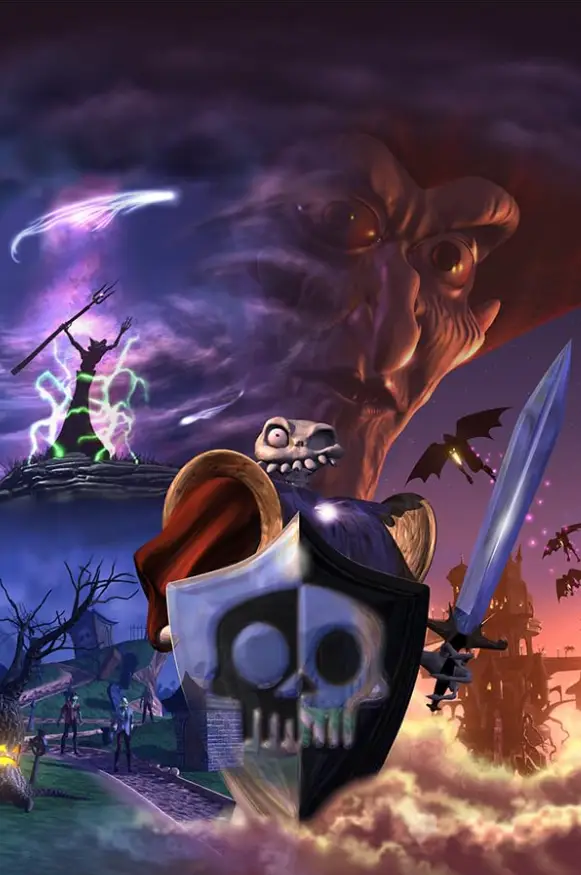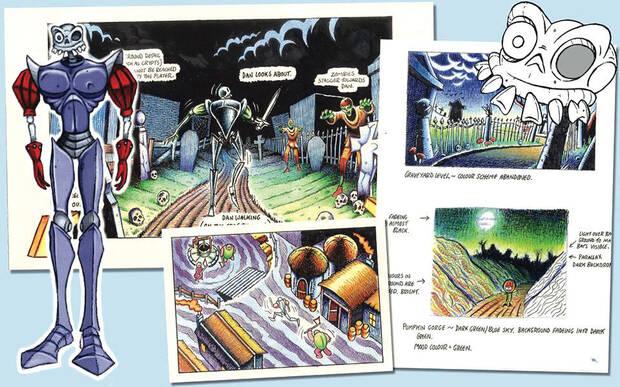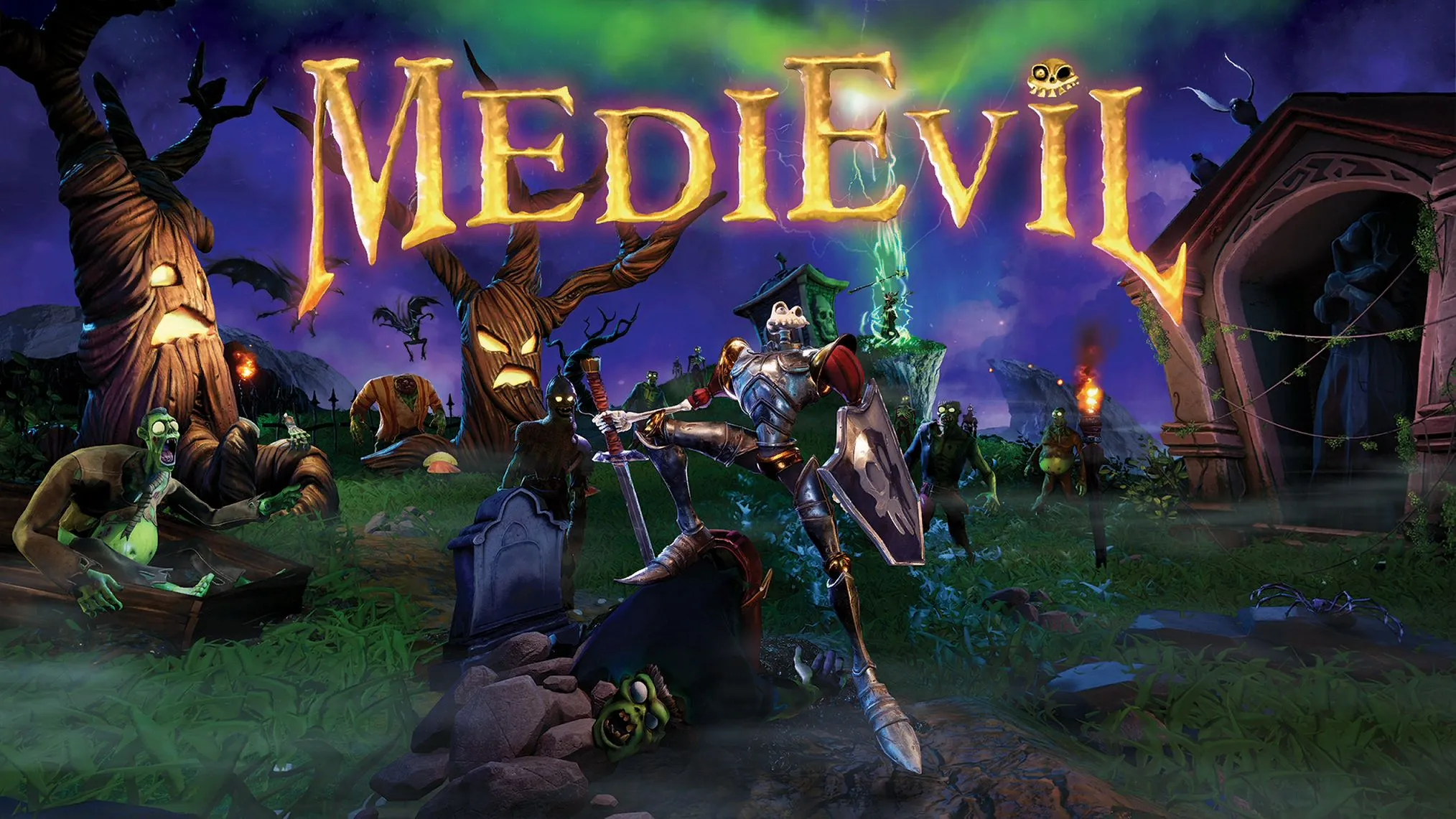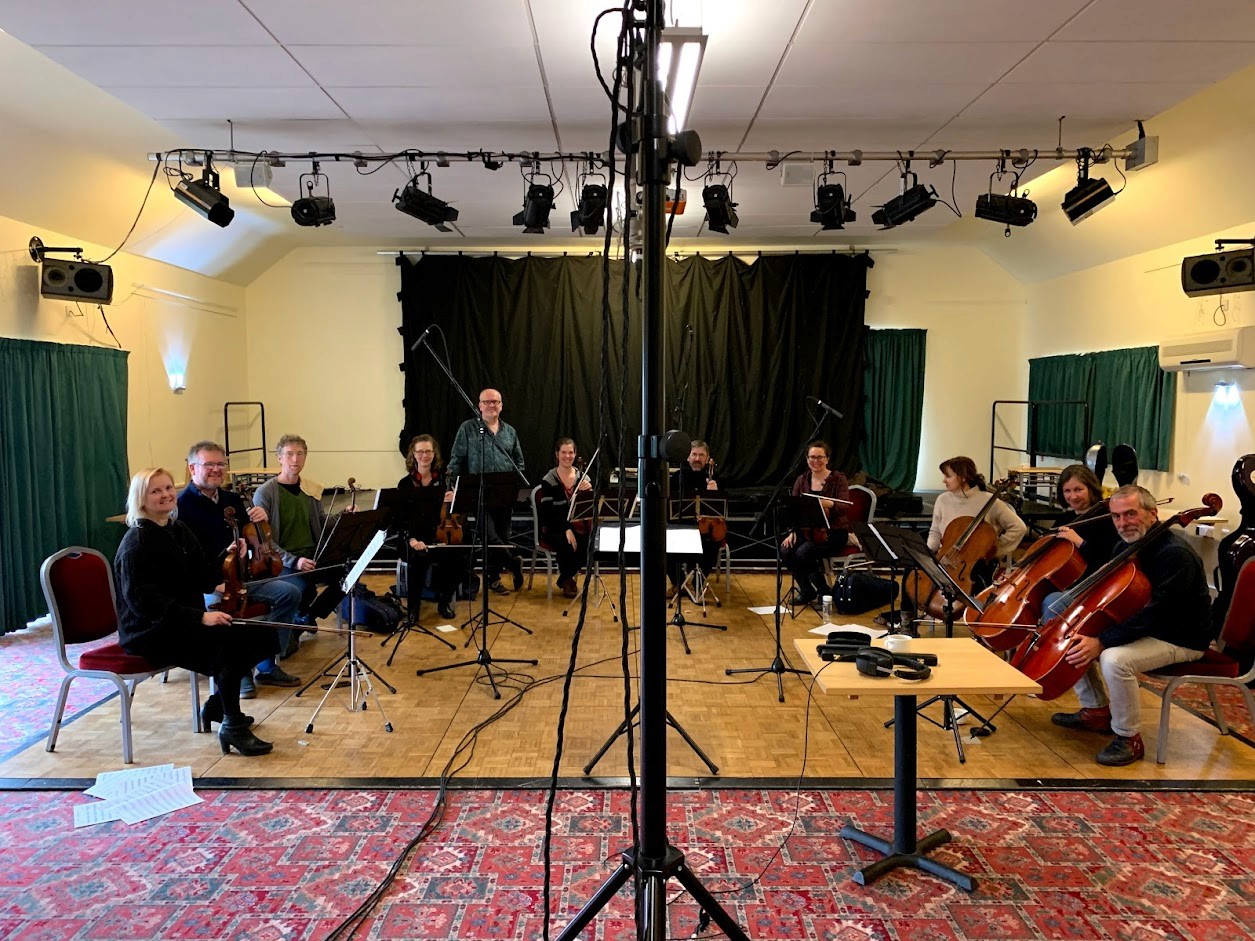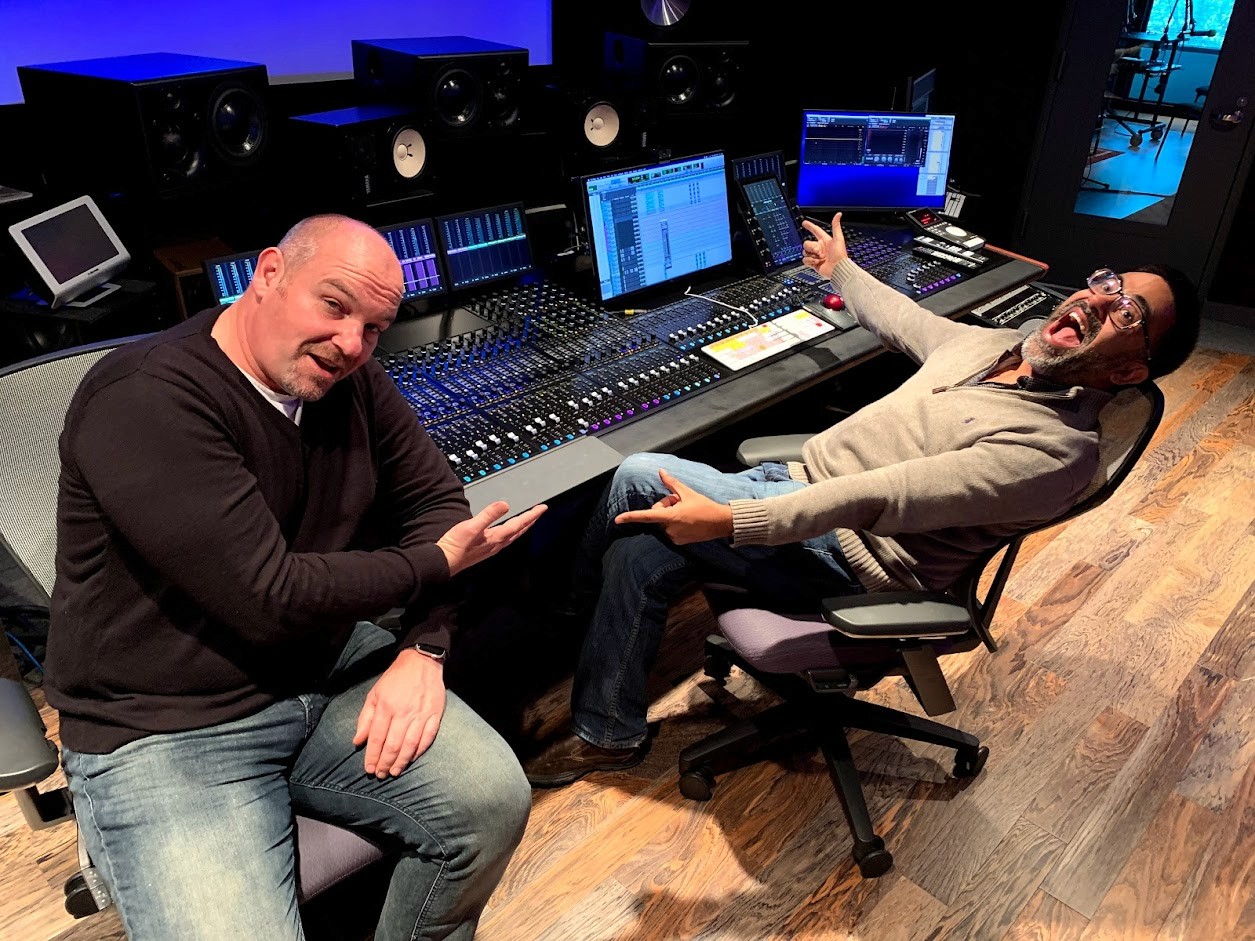MediEvil
Format
Video Game
Released
MediEvil 1 – 1998, MediEvil 2 – 2000
MediEvil Resurrection – 2005
MediEvil PS4 2019
MediEvil is a franchise for the PlayStation developed and published by Sony; a gothic fantasy / comedy horror action adventure starring an undead skeleton in a suit of armour named Sir Daniel Fortesque. The premise was to reference classic Capcom arcade games from the 80s – namely Ghosts ‘n’ Goblins & Ghouls ‘n’ Ghosts - bring the game into a 3D environment and give it a look akin to Henry Selick & Tim Burton’s ‘The Nightmare Before Xmas’.
My journey with MediEvil started in 1997. Back then I was the in-house composer for Millennium Interactive. Game designer Chris Sorrell popped into the music studio one day clutching soundtracks from Interview with a Vampire, Dracula, Nightmare before Xmas and Edward Scissorhands as references for his new game.
I’d never written for an orchestra before nor was there the budget to record an orchestra. I was classically trained, and had always pushed to record players wherever possible but nothing to this scale.
Armed with a sound module, a sampler and a love of film scores I rolled up my sleeves, analysed the film scores I’d been given and got stuck in. A few months later Paul Arnold joined me, a few months after that Sony who were interested in publishing the game bought the whole studio!
This case study is my story that bookends the franchise, the experience, pitfalls and hurdles of working on the first MediEvil game and just how different it was to come back and work on the remake 20 years later.
MediEvil 1
Nightmare with no Xmas! How to write for a synthesised orchestra with precious few sounds and even less experience!
It’s 1997, I’d been writing scores for games for seven years at this point but the first five were writing ‘chip music’, that is music programmed and generated by the sound chip of the games machine itself, I’d only moved into writing ‘real’ music with synths and samplers in a recording studio for the past two. Recent scores for Silverload and Defcon 5 were moving into a melodic film score style of writing but it was all still very new to me. And my writing style was based around riffs. I’d come up with a short idea, 4 or 8 bars of music, loop it and build on top of it. Effectively a bottom-up approach.
Since gaming began, games music had two stigmas, both of them due to technical limitations. The music sounded like bleeps and bloops and was repetitive - irrespective of how long the task took the music didn’t change. Once technology evolved to the point where ‘chip music’ wasn’t a prerequisite it meant the music sounded better but it still didn’t change irrespective of how long it took to complete the task so it remained repetitive, normally cheerful and upbeat too - it still sounded like games music. For certain genres this still worked well – the Frogger remake I worked on in ’97 was cheerful upbeat and repetitive with a dollop of funk. The references Chris gave me sounded nothing like that, instead they were beautifully written melodies, performed by some of the best orchestras in the world.
I found myself justifying why games scores I wrote back then didn’t sound anywhere near as good as film scores simply because I was writing with samples rather than the real thing. Turned out whilst convenient it wasn’t entirely accurate. Orchestral film scores I discovered are melody driven. Compose the tune first and the backing after; a top-down approach and precisely the opposite of how I’d been writing. Alas I didn’t have this lightbulb moment until a few years later.
So not only did I not know the difference between melody vs riff-based composition, I also had very few orchestral sounds. I had a synth module (a Roland JV1080) which had strings / woodwinds / percussion. Brass was very hard to synthesise well so avoided those as they sounded poor. I had a sampler, an Akai S3200 but no orchestral sounds. My first idea to remedy this was to buy orchestral sample CDs, the Peter Siedlaczek Advanced Orchestra CD-ROMS were great, other sample CDs came as orchestral riffs on audio CD which had to be sampled in manually.
Buying the latter was a big help as I could start an idea using a ‘real’ orchestral riff and layer material on top. I bought sampled choirs, strings, anything I could sample to bolster the limited sounds I had access to.
Another layer of complexity came about when analysing what makes the film scores we were given as reference - especially those by Danny Elfman - work so well. Whilst I couldn’t buy scores on paper, I had enough musical training to analyse how he wrote and learned that so much of the humour comes from writing melodies that weave between intricately orchestrated sections which change every few bars. (Orchestration is the art of arranging a piece of music for the orchestra, who plays what, how are the chords and melodies split up etc.) :- strings and brass -> woodwind and percussion -> choir and strings -> percussion and brass etc. It keeps the music sounding alive and vibrant with an energy that’s perfect here.
So…. into the melting pot went orchestral sample libraries, riffs, choirs, percussion and sounds from the JV synth into what we called an Autoload, a template that we would use as a basis to write each track with. Our analysis concluded a mixture of comedy writing with slapstick semitonal movement and pizzicato strings, chord writing using a lot of minor thirds and diminished chords, madcap orchestration which constantly changes and write melodies that you hope folks will remember. No pressure.
From all of that anguish I discovered it was a style of music I loved writing. The blend of fantasy, magic, horror and humour intertwined with learning to write for a sampled orchestra within the technological limitations of the time was frustrating but also immensely gratifying.
To cap it off, the game wasn’t ready!
Game dev is a complex beast, so much of the technology needed to drive the game and develop for it was being written as we were working on it, this was Millennium’s first fully fledged game in 3D, tech to learn, design challenges to overcome. All of this meant writing music in the proverbial dark, we couldn’t Dan running around fighting monsters on any of the levels apart, just concept adorning the walls. So that’s why these tracks were called MIG, it stood for MediEvil In Game, as we had no idea what level they would end up on! One technical restriction we discovered that in order to make the music fit on the CD whenever the track looped there’d be a noticeable gap as the CD laser seeks to the beginning of the track, to overcome this we wrote two-minute tunes which peak in the middle of the track so the start and end are quiet you wouldn’t notice.
Not only were we writing music for in-game levels there were cut scenes (the narrative sequences between levels which propel the story which at the time were called Full Motion Video sequences), short jingles (e.g. lost a life, start a new level), map screen, title music etc. All in the score was about an hour long which is about the same as a film. Being in-house meant that we were also creating the sound design and implementing dialogue in multiple languages too!
Here’s a couple of examples. I resisted the urge to re-master them to sound better so they are exactly as they were from the 1998 original.
MIG 01 – The Awakening.
From the first level and the second track written. The woodwind / string chords from 0:13 were samples of a real orchestra, working out how to write a tune around them. This track we came back to at the end of the writing phase, it was a bit too samey in the middle and we’d learned so much we added a new section from 1:07.
MIG 11 – Enchanted Earth.
I’d been listening to a lot of 70s horror film scores and repeated piano ostinato lines worked well so I wrote my own simple riff and based the rest of the track around this. Most of the orchestral sounds, harp, bells and whooshes came from the Roland JV1080, the clarinet I discovered could be surprisingly expressive. Choir and strings from the Akai sampler.
MediEvil 1 came out on October 9th 1998 and it went down very well. It was humbling to read how many reviews mentioned music. I’ve had more folks ask me about my work on MediEvil than any other. I’m writing this almost 25 years after it came out and I’ve already had 10 new messages this month on YouTube and email - which is nice…. 😊
And finally, here’s a YouTube link to the intro sequence showing the introduction of Zarok, casting the spell to turn the towns’ inhabitants into his own private army which inadvertently wakes up Dan. Coincidentally MediEvil’s main theme came from a melody I wrote in this intro sequence @ 1:47, a happy accident that stuck.
At this point I’d like to take the opportunity to list the full music credits but it’s rather a short list….!
Music written, performed and produced by Andrew Barnabas and Paul ‘Bob’ Arnold.
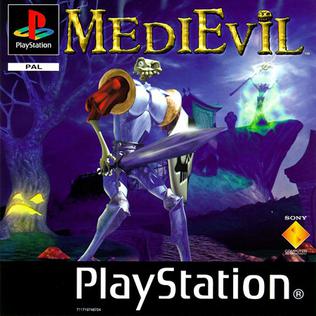
MediEvil 2019
The chance to go back and do it again but this time properly? Naah, that can’t be true…. Can it?
MediEvil 2 and MediEvil Resurrection came out in 2000 and 2005 respectively. In the intervening years there was a lot of interest from fans, sequels & prequel concepts from both the original and other development studios but the powers be at Sony didn’t bite. I’m a hired hand so have very little influence, but I’m still asked all the time about a new MediEvil. When I heard rumours of a new game I dismissed them, been there and nothing ever came of it. Then at a Sony press conference in late 2017 Shawn Layden, Sony’s global Chairman revealed a T-Shirt with Dan Fortesque’s head on it, OK this is real! Bob and I were inundated with messages which was wonderfully heartwarming. Truth is we’d not been asked so had nothing to report. Then in early 2018 Sony America did get in touch….
Up to this point Med 1, Med 2 & Med Resurrection had all been developed by Sony Cambridge (the name Sony gave to Millennium Interactive) and published by Sony Europe. The new game simply called ‘MediEvil’ is a PS4 remake of the first game, developed by Other Ocean Emeryville and published by Sony America. This was a whole other ballgame in every department. Sony Santa Monica were entrusted with audio, the same team that work on God of War and Last of Us. To be given the opportunity to remake the score from the ground up with all the bells and whistles that’s possible with PS4 tech AND collaborate with an audio team who work at the highest AAA level was a literal dream come true, I don’t know how many times Bob & I joked about ‘what our younger selves would think of this’.
If you’re curious, I took a 4 minute video walking around Other Ocean’s offices…..
Once we’d come back down to earth it was down to business; what could we do now. The fact that it was a remake turned out to be a double-edged sword. On one hand we have the opportunity to realise with a symphony orchestra and choir tracks that folks have written to us about for 20 years (Med Resurrection had a live orchestral score with half the tracks from the original, here we could record the rest). On the other hand, the original was my first attempt at writing for (synth) orchestra. I’d like to think my knowledge had improved having had the good fortune to work with the real thing for 18 years. I cringed at the choices made in orchestration (how to arrange for orchestra) however I couldn’t veer too far away from the source material as people liked the original and we were told ‘don’t mess with it!’ And the music didn’t change, we wrote tracks that were at a medium tempo that would work if you were enjoying the beautiful scenery or being surrounded by a horde of - admittedly slow - zombies, it didn’t change to reflect what happens on screen. Back in ’98 the best you could do was switch to a more intense track for boss fights. In-game music was simply aural icing on a visual cake. Today we have very clever scores that vary throughout as well as follow the undulating emotions of the player.
Dilemma, do I stay or do I go?
So how do I revisit non-interactive in-game tracks that are at a fixed tempo, written using very basic forms of orchestration that might not translate as well to being recorded properly, turn them into interactive tracks that vary in intensity and speed to better match what the player is experiencing but still sound like the same track.
This required a fair amount of trial and error…..
Here’s what we concluded :
1. Orchestration.
When analysing what was liked about the original, turns out it was the melodies, folks like humming a tune after all. Even though they were written bottom-up melody over riff fashion, they were still strong. What would happen if I took the melody and any other prominent part from the original and wrote a new more technically competent accompaniment! Turns out you can get away with it beautifully. So that’s what we did, hooray!
2. Interactivity
This was by far the most challenging hurdle to overcome. Two-minute stand-alone tracks that repeat ad infinitum, how can we make them react to gameplay highs (getting swarmed by enemies) and lows (pottering around enjoying the scenery) without losing their essence.
First off, break the tracks down into musical stems that could be triggered independently. For an orchestral piece, split up sections of the orchestra - strings, brass, woodwind, percussion and in addition choir. Here we went to another level of granularity in splitting up fast and slow passages. Record the strings on their own playing legato (long notes) and a separate pass playing short rhythmic notes, repeat this with every section of the orchestra. That alone gave us much more scope to extend the track during run time. Interactive music systems have clever scripting which means that we could ask it to choose to play a handful of musical stems together from a pool and give some of them greater weighting. We could also choose whether stems repeat or play only once. A lot of trial and error to come up with the best results.
Example, here’s a short video I took of the strings playing a legato pass from one of the new tracks for Pools of the Ancient Dead (full track on the Listen page). I’m filming in the control room, Nic Raine conducts on the left screen and the orchestra on the right. Jan Holzner, the amazing engineer we’ve worked with since Primal sits in the middle, Michael Hradisky assistant engineer on his right and ProTools which we’re recording into on the middle screen.
Secondly, play through each level and identify 3 key points where it noticeably steps up either in story or intensity - effectively turning each level into a 3-act story and have the music develop in tandem. E.g. if each musical track was 2 minutes – 120 seconds – long then divide this into 3 x 40 second musical “acts”. During act 1 of the level choose to randomly play from a pool of stems that make up those first 40 seconds. Then once the player progresses to act 2, introduce stems from act 2 so you double the choice; similarly, by act 3 the track is played back from a pool of stems comprising the whole track.
Whilst that helps to extend the shelf life of each track demonstrably, aside from richer orchestration there wasn’t anything new in the tracks. So let’s add some. We chose to add more in two ways.
The first was to add an improvised woodwind solo on clarinet or flute. Play a ‘backing’ section of a track – by backing I mean underscore which has rhythm and structure but no melody and ask our amazing woodwind player Julian Landymore to play a MediEvil sounding solo over the top. It sounded great. Solos aren’t suitable for lengthy repeats so made sure they only play rarely.
Secondly, add a rhythmic spiccato line. Bob came up with this idea. The tracks were all reasonably slow, akin to 19th century romantic orchestral pieces. Personally, I prefer in-game music that doesn’t take prominence and isn’t too fast. Fast music after a while becomes relentless and our ears filter it out. Slower music with long evolving melodies that help narrate the level don’t have the same effect so isn’t filtered. However, it doesn’t reflect any change in player intensity. Pottering around exploring lush fauna or being chased by a horde, it doesn’t change. With game audio tech now, the game is better aware of the player’s emotional state – using data gleamed from how much health / how many enemies are nearby and circling etc. The tech now allows you to seamlessly add additional layers of music whilst a track is playing. The solution we came up with was to add a rhythmic line recorded separately by a small string section that play passages twice the tempo of the track. Effectively this would give the game the chance to make any track sound twice as fast, giving a lot more impetus to the player but without detracting from melodies’ folks like from the original. We recorded those later in England with our regular string collaborator Steve Bingham, here he is standing with the 10 players.
Each track consisted of orchestral recordings for each ‘section’ of the orchestra – strings / woodwind / brass / percussion and choir. We recorded this in Smecky Studios in Prague with the City of Prague Philharmonic Orchestra & Chorus, where we’ve recorded all of our major scores – including MediEvil Resurrection in 2004. I did manage to tick a box I never thought I would. Nic Raine suggested I have a go at conducting so here’s 20 seconds of me conducting the end of the intro cut scene played by the full orchestra, no point in splitting this into sections as it’s only ever heard once.
This turned into the largest music production I’ve ever worked on. I asked an engineer at Sony Santa Monica to send me a ProTools screen shot of a mix in progress (ProTools is pretty much the industry standard digital audio workstation) and he said it wouldn’t fit on one page, he sent me 13 pages of screen grabs for just one track! Each track took a humungous 300 – 350 audio channels, blimey!
The final cherry on top was for - SPOILER ALERT – the final cut scene in the game when you complete the game and collect all of the chalices. In the original Dan arrives at the Hall of Heroes, he interrupts a medieval banquet – in a good way and is finally accepted. Being a grand medieval banquet, I sourced sounds that sounded a bit like medieval instruments on the JV synth and wrote something hopefully suitably old sounding. Here why not do it properly, I found a wonderful musician who plays medieval instruments called Lizzie Gutteridge, she came over and played a variety of authentic old instruments. Here’s a short clip of her playing a Shawm.
And to round things off here we are in Scott Bergstrom’s mixing room at Sony Santa Monica. I’m filming, Bob’s in the room as well as Monty Mudd, the amazing music supervisor and implementer as we’re reviewing the final cue for the official soundtrack which comes with the deluxe version of the game. It just happens to be the medieval track from the Hall of Heroes banquet scene I mention above and a big Hollywood Ending!
It was an incredible opportunity to come back to MediEvil and do it justice, seeing how far my musical knowledge and gaming tech had improved in 20 years. We did a ton of interviews and podcasts about our involvement; the credits track was performed at the PlayStation concert at the Royal Albert Hall. MediEvil is the score I keep receiving comments and folks keep asking whether there’ll be a reboot of MediEvil 2 and even a MediEvil 3.
I’m certainly crossing my fingers!
Thanks for reading.
MediEvil 2019 Music Credits
Score Composed
Senior Music Director
Music Supervision & WWISE Implementation
Music Engineering & Editing
Score performed
Conducted
Concertmaster
Recorded at
Recording Engineer
Assistant Engineers
Translator & Music Assistant
Orchestra & Choir Contractor
Choirmaster
Orchestrations
Music Copyist Services
Conducted
Scores prepared
Recorded and edited
Woodwind Solos performed
Medieval Instruments performed
